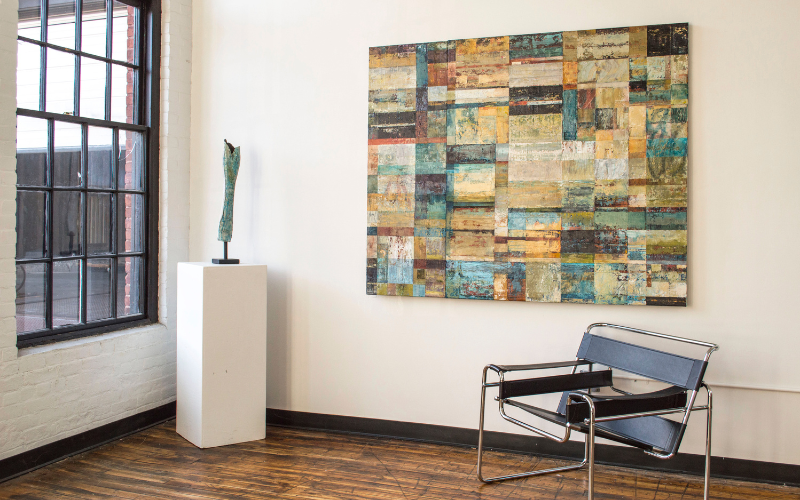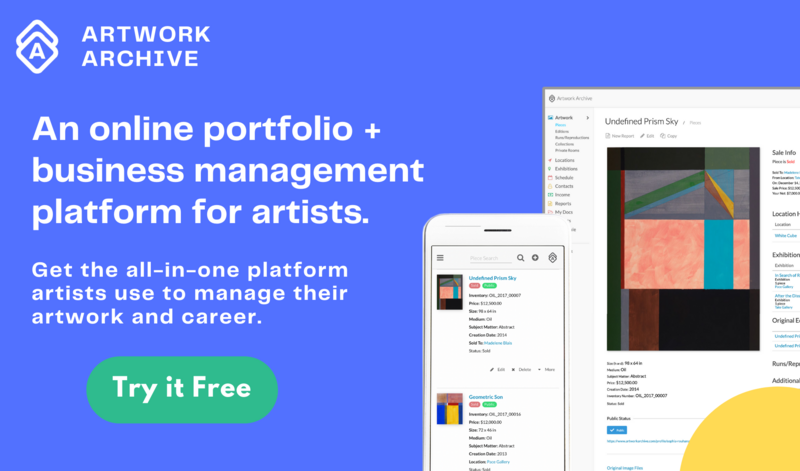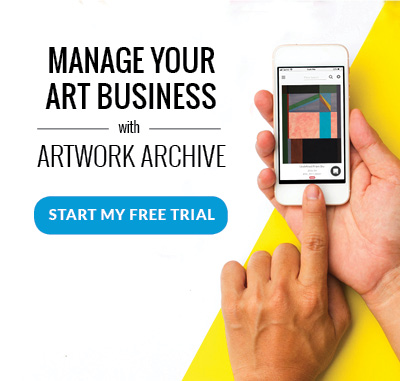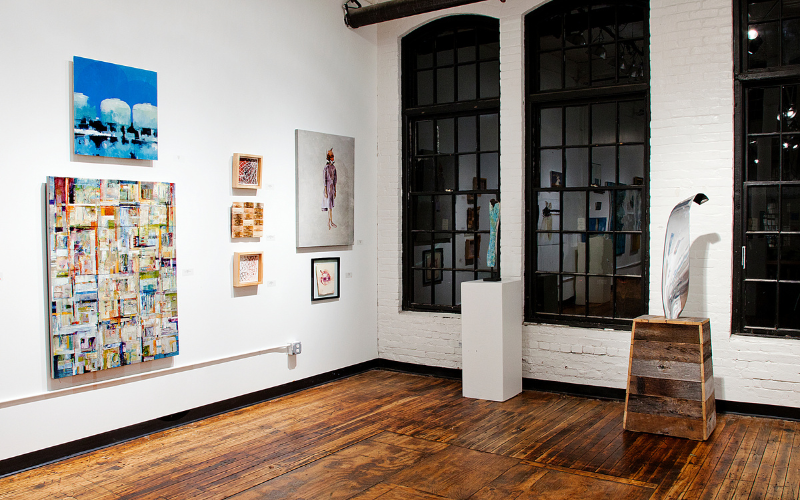
Candita Clayton Gallery, Pawtucket, RI. Photo by: Scott Lapham. Artist work in this image: Sean Thomas, Kristin Street, Wendyll Brown, Nidal Fakhouri, Shari Weschler, Tiffany Adams, and Christian Rubeck
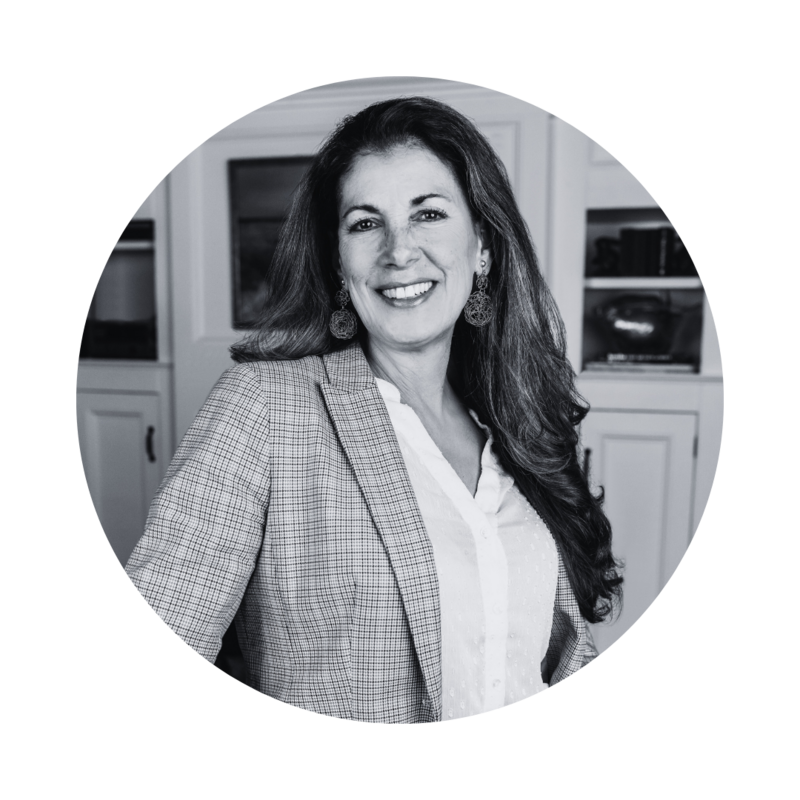 |
Candita Clayton is a respected gallerist and art advisor renowned for her discerning eye and collaborative spirit in the New England art scene and is the founder of the Candita Clayton Gallery.With over 15 years of experience, she has curated hundreds of exhibitions that spotlight both emerging and mid-to-late-career artists from Rhode Island, New England, and beyond.She is deeply committed to making art accessible for all, championing artists and advocating for their representation and sustainability within the industry. Her approach is described as joyful, intuitive, and rewarding, aiming to bridge the gap between artists, art enthusiasts, and the broader community. |
"Trust me when I say you can have a lucrative career as an artist and ditch the starving artist narrative."
These days, an artist can launch a full-blown career through Instagram alone. Direct sales are easier than ever, and social media gives you access to collectors you may never meet in person.
But, a lot of you still crave something beyond that: gallery representation.
We sat down with Candita Clayton—gallerist, curator, mentor, and advocate for accessible art spaces—to talk through what really builds trust between artists and galleries.
Her perspective pulls back the curtain on the unspoken rules, overlooked red flags, and daily habits that help artists thrive in gallery relationships.
If you've ever wondered what a gallerist is paying attention to behind the scenes, this is your backstage pass.
How Candita Became the "Accidental Gallerist"
Before opening her namesake gallery in Pawtucket, RI, Candita Clayton was juggling three businesses in a beautiful commercial space—none of which were a gallery. “I had always secretly wanted to open a gallery but honestly never understood how the business model could be successful,” she recalls.
Then a local gallery closed.
And when artists were left without a space to show, a friend encouraged her to open her space to the community. “With the help of a terrific group of artists looking for a new space to show their work, we opened a show with great success," Candita remembers. "I jumped in and never looked back.”
Since then, she's worn many hats: mentor, curator, collaborator on design projects, and connector of artists to opportunities. But at the core of her work is a simple value:
“I'm passionate about making art accessible for all.
The gallery should be a welcome place to experience art (for free) without pressure, where everyone feels welcome.”
—Candita Clayton
Candita Clayton Gallery, Pawtucket, RI. Photo by: Scott Lapham. Painting by Wendyll Brown. Raku Sculpture by Tiffany Adams
What Galleries Still Offer
Candita has a front-row seat to the shifts in the art world and has watched artists carve out their own paths using digital platforms and direct sales. She supports that, but also sees where (and why) galleries still matter.
“In my opinion, selling and building a career as an artist are not the same thing.
Having a good established gallery behind an artist still plays an important role in providing opportunity and exposure."
For Candita's work, that includes helping artists apply for grants, submit to juried shows, and build portfolios strong enough for museum collections or major commissions. She pays attention to when artists talk about their dreams, then she helps make them possible. “A robust resume helps us all,” she insists. “I’m constantly looking for opportunities for my artists.”
Still, she doesn't expect one gallery to do it all. "It's unlikely that one gallery can help a full time artist meet all of their financial goals," Candita explains. “It’s important to work with regional galleries that don’t compete with each other for sales—and to put effort into direct marketing through your studio and social media.”
And, while she believes in the role of galleries, she doesn’t romanticize the gallery model itself. “It’s flawed,” she admits. “You cannot sit around in a beautiful gallery and wait for the occasional vistor who may or may not buy something. You have to find and cultivate your customer."
That’s why she focuses on design partnerships—working with architects, interior designers, and professionals who regularly source and place artwork. It creates consistent opportunities for artists and keeps her business active.
“I work hard for the money. I’m constantly looking for ways to get artwork in front of people who can buy it. If an artist wants to focus on making the work, a good gallery can help them keep doing that.”
So, Let's Say You Do Want to Work With a Gallery...
You know it could support your career, expand your reach, and help you focus more on the work itself. But the thought of reaching out makes your stomach flip.
How do you introduce yourself without feeling awkward or overly self-promotional? What do you say? What do you send? When do you follow up?
Candita has seen every kind of gallery pitch. And in her experience, the first point of contact is where things often fall apart.
How to Approach a Gallerist (the Right Way)
There's a difference between introducing yourself and ambushing someone. And, unfortunately, Candita's seen the latter too often...usually at someone else's opening, when her attention is already pulled in ten different directions.
“What NOT to do is approach me during an event or opening reception of another artist’s work with your cell phone out and pictures of your work in my face.
That's a hard no.”
It might feel bold in the moment to you, but to a gallerist juggling event logistics, artist support, and collector conversations, it reads as disrespectful and opportunistic.
So what works better?
Candita suggests "an introductory email with a link to the work an artist wants to present to me.” You're not doing a sales pitch here. Be direct, be professional, and keep it simple.
And if you don’t have a full body of work yet? Wait until you do. “I’ve received emails where an artist is so emerging that they're only presenting three works that are too underdeveloped to be taken seriously,” she adds.
One way to get on her radar that almost always works is a recommendation from someone she already trusts.
“I've established some of my best relationships when an artist from my stable recommends a fellow artist to me," she explains. “This says they believe the quality of this person’s work is up to my standards and worth seriously considering.”
Candita’s Must-Haves for a First Contact Email
Before reaching out to a gallerist, Candita recommends making sure you include:
☑️ Polished body of work (not just a few pieces)
☑️ Link to a clean, well-organized portfolio (no large, confusing, mislabeled attachments)
☑️ Short intro and clear subject line
☑️ Professional tone and bio
What Builds Trust Over Time
Okay, so let's say you're in. Representation is secured. Now what? Getting picked up by a gallery is one thing. Buliding a strong, lasting relationship is something else entirely.
1. Get the Contract (Yes, Every Time)
“When I opened the gallery, every relationship was built on a handshake," Candita told us. "But, a few years in, I learned that it serves everyone to have a plainspoken contract."
If a gallery doesn’t offer one, you're allowed to ask. Here’s (just some of) what Candita suggests you get in writing:
-
How long your work will be held by the gallery
(Candita usually keeps pieces for a year) -
What happens when a collector wants more work down the line
(especially if the gallery was the one who made the introduction) -
When you’ll be paid
(Her policy is within 30 days)
“It serves everyone to spell out exactly what we can expect from each other and this professional partnership," she explains.
Partnership is the key word here. Remember, these days, artists have more control over their sales than ever. But once a gallery gets involved they become part of the picture too.
“I always say, ‘Dance with the one that brought you,’ meaning if I am the person who introduced your work to a buyer, we're in it together.
Going around your gallery for sales will likely end badly.”
A contract prevents misunderstandings. It helps clarify what happens if a collector contacts you directly, or if a piece sells after an introduction.
Use the contract as a way to ask the things that often go unsaid:
-
What’s the gallery’s policy on collector relationships?
-
Are direct sales allowed during the representation period?
-
How will the gallery be promoting your work?
Give That Contract a Home:
A clear agreement is important, but it's even more useful when you know where to find it at all times.
Once you have a contract in place, upload it to My Docs on Artwork Archive. That way, if you forget what your payment terms were or how long the gallery holds your work, you don’t have to dig through your inbox or a desktop folder.
2. Make Their Job Easier
Once the logistics are in place, the real work begins.
Gallerists are busy people. Candita runs multiple shows at a time, all while cooordinating with collectors, responding to submissions, and tracking dozens of artists. And the ones who stay in her orbit long-term have a few things in common:
-
They share new work without being asked
-
They keep their records up to date
- They send what’s needed when it's needed
When an artist makes it easier to advocate for them, that effort gets noticed. “I love it when an artist is organized and takes their business seriously. That makes a great impression and creates lasting relationships.”
She notices who sends images with full details. She remembers who responds quickly. She keeps track of who turns things in on time, and who leaves her following up the night before a deadline.
“Good communication is key to my long-term relationships with artists.
Let me know what you're working on. Share images and information about new work as it’s being developed. These are at the core of my best artist relationships.”
“We’re both invested in this partnership,” she reminds us. “The better the communication and information I have, the more success we can share.”
If Candita Had a Green Flag List, It Might Look Like This:
✅ Your work is ready for collectors
✅ Details are attached to every piece
✅ You’re not making your gallerist chase you down for files
✅ You're not missing deadlines
✅ You’re treating your studio like a business
If this list made you think, “I should probably update my spreadsheets…” Don’t.
Artwork Archive helps you do all of it (and more) without spending hours in Excel. Click here to see how it works in your studio.
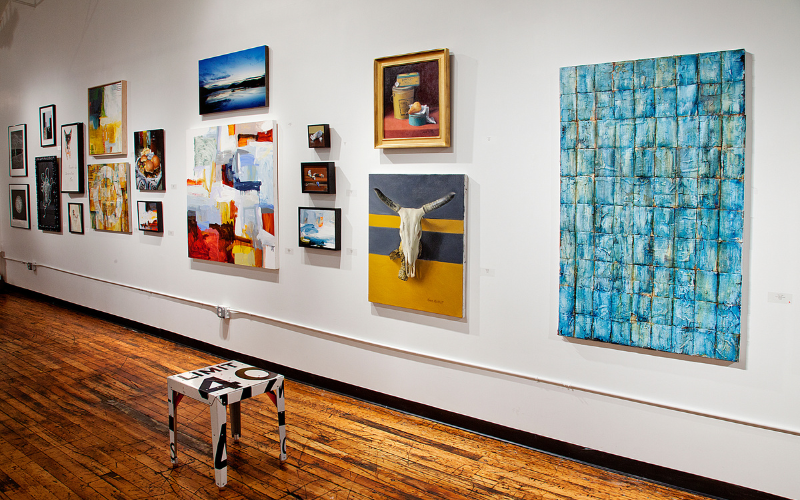
'The Really Big Group Show' at Candita Clayton Gallery, Pawtucket, RI. Photo by Scott Lapham.
What Ends Gallery Partnerships
When we asked Candita where things tend to fall apart between artists and gallerists, she pointed to real moments she's experienced: unanswered emails, missing files, poor communication around sales, and even artwork delivered with messy, unfinished edges.
“Common mistakes [also] include not getting images and information to me in a timely manner so that I can appropriately present for specific projects,” she continues. “The quicker I have all the information, the more I can present.”
But it doesn't always come down to logistics. Sometimes, the work simply isn’t the right fit. “There have been times where I have personally loved an artist’s work, but it was difficult to place with my ideal collector,” Candita admits. "This can be a painful conclusion to the relationship.”
Other times, it’s harder to name.
“A difficult personality or a sense of entitlement can also create tension.
Things usually go sideways when expectations aren't clear, especially around what the gallery can realistically offer and where the artist sees their own career."
Most gallery partnerships don't end because of one dramatic moment. Instead, it’s usually a bunch of little things that, overtime, make the relationship harder to keep going. Even the best work can’t carry a partnership on its own. If a gallerist starts to feel unsure about your timelines, your follow-through, or how you handle things behind the scenes, it becomes harder to keep putting you in front of bigger opportunities.
Red Flags Candita Watches For:
🚩 Unfinished pieces or sloppy presentation
🚩 Missing or delayed images and info
🚩 Missed deadlines
🚩 Inconsistent communication about availability
🚩 Going around the gallery to sell directly to collectors
🚩 A general sense that the artist isn’t showing up for the partnership
It's easy for this stuff to slip through the cracks when there's no system in place and everything's stored in your head.
That’s why so many artists use Artwork Archive to track pieces, keep details in order, and avoid the slow build-up of avoidable mistakes.
What Artists Often Overlook
When Candita meets with artists in her one-on-one mentorship sessions, one of the first things she brings up is the fact that creative growth and business structure have to develop side by side.
“An artist must realize at the beginning of their practice that they're a solo-preneur as well as an artist,” she points out.
"The business of art brings the most questions."
And it makes sense. As an artist, you probably already know how easy it is to pour everything into your creative work. Admin tasks can feel secondary…until you need a polished image or a record of where a piece went.
Those are the things Candita pays attention to. They help her advocate for you. They make gallery partnerships easier. And when they’re missing, the wheels start to wobble.
That’s why she recommends tools like Artwork Archive. It’s what she points artists to when they need help tracking their portfolio, staying on top of deadlines, and pulling materials together that galleries can actually use.
“Trust me when I say you can have a lucrative career as an artist and ditch the starving artist narrative," Candita says. "If I believe in you, you need to believe in yourself.”
We're All About Ditching The Starving Artist Narrative:
Which is exactly why we built Artwork Archive.
We got tired of seeing creative people give up on pursuing their careers when the logistics became to overwhelming. So, we've spent the last decade creating tools artists can rely on.
Click here to find out exactly what tools you can start implementing in your own art practice.
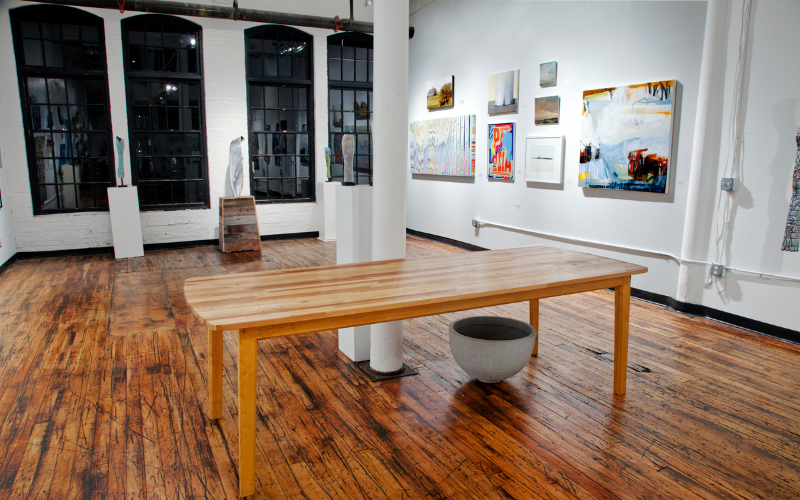
'The Really Big Group Show' at Candita Clayton Gallery, Pawtucket, RI. Photo by Scott Lapham.
Not Ready for Gallery Representation Yet? This is the Part You Can Practice Now
There’s no rule that says you have to land a gallery first. If you're still figuring things out, that’s fine. There's a lot you can do in the meantime.
“Start by building a solid body of work. Bring it to small art fairs or creative venues.
Feedback is freely given there, and it helps you grow.”
Even if you’re not making formal sales, showing your work publicly gives you a chance to practice the professional habits you’ll need later: prepping your pieces for display, writing descriptions, making labels, and photographing your work clearly.
She also suggests connecting with other artists. “Asking more established artists for feedback is really helpful as you prepare for representation or bringing your career to the next level,” she shares.
Everything you do now sets the tone. If you can start documenting your work, sending complete info, and staying on top of your own deadlines, you’re already ahead.
“Start preparing before the gallery ever sees your work,” Candita pushes. “That’s what shows you’re serious.”
Final Takeaways from a Gallerist Who’s Rooting for You
Candita Clayton has dedicated the last fifteen years to helping artists prepare for sustainable careers. If you’re leaving this conversation with anything, let it be this:
“Don’t give up. Just because one gallery rejected you doesn't mean the perfect fit isn't out there. Collect the ‘no’s’—they teach you how to get to ‘yes.'
“It takes courage and commitment to be successful. Strive for excellence."
—Candita Clayton
There's no exact formula for this career (or this industry in general), but Candita Clayton has seen how artists who grow their careers pay attention to how they show up, who they connect with, and what tools they rely on.
That’s the same vision we hold at Artwork Archive. If you’re building something real, we’re right here with you.
And once you do, people like Candita are ready to work with you. Start a free trial and see how Artwork Archive fits into your own process.
